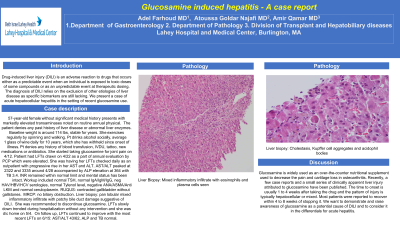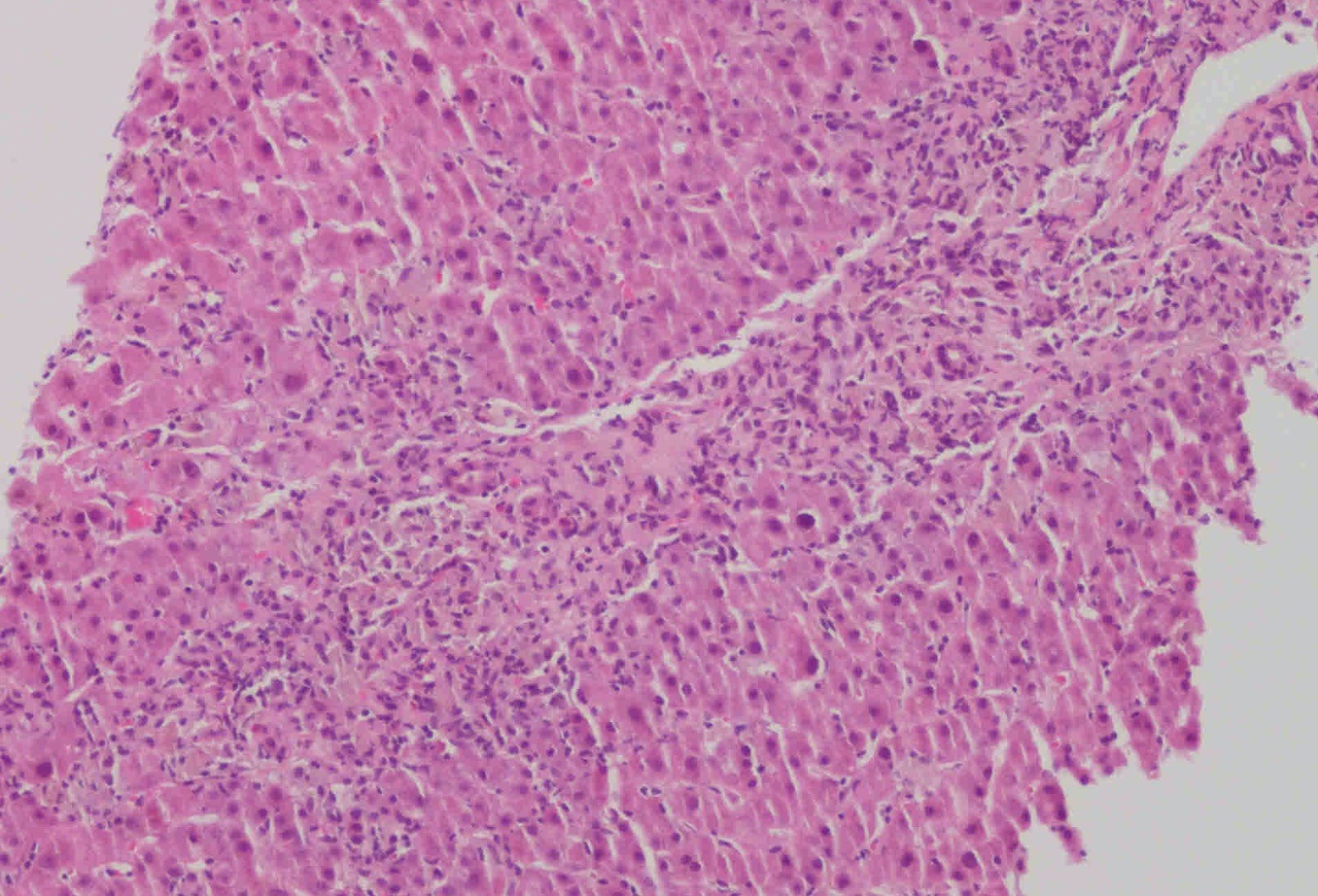Back


Poster Session E - Tuesday Afternoon
Category: Liver
E0575 - Glucosamine-Induced Hepatitis - A Case Report
Tuesday, October 25, 2022
3:00 PM – 5:00 PM ET
Location: Crown Ballroom

Has Audio

Adel Farhoud, MD
Lahey Hospital & Medical Center
Burlington, MA
Presenting Author(s)
Adel Farhoud, MD1, Atoussa Goldar-Najafi, MD2, Amir A. Qamar, MD1
1Lahey Hospital & Medical Center, Burlington, MA; 2Lahey Hospital & Medical Center, Burlington, MA
Introduction: Drug-induced liver injury (DILI) is an adverse reaction to drugs that occurs either as a predictable event when an individual is exposed to toxic doses of some compounds or as an unpredictable event at therapeutic dosing. The diagnosis of DILI relies on the exclusion of other etiologies of liver disease as specific biomarkers are still lacking. We present a case of acute hepatocellular hepatitis in the setting of recent glucosamine use.
Case Description/Methods: 57-year-old female without significant medical history presents with markedly elevated transaminases noted on routine annual physical. The patient denies any past history of liver disease or abnormal liver enzymes. Baseline weight is around 114 Ibs, stable for years. She exercises regularly by spinning and walking. Pt drinks alcohol socially, average 1 glass of wine daily for 10 years, which she has withheld since onset of illness. Pt denies any history of blood transfusion, IVDU, tattoo, new medications or antibiotics. She started taking glucosamine for joint pain on 4/12. Patient had LFTs drawn on 4/22 as a part of annual evaluation by PCP which were elevated. She was having her LFTs checked daily as an outpatient with progressive rise in her AST and ALT. AST/ALT peaked at 2322 and 3335 around 4/28 accompanied by ALP elevation at 364 with TB 3.4. INR remained within normal limit and mental status has been intact. Workup included normal TSH, normal IgA/IgM/IgG, neg HAV/HBV/HCV serologies, normal Tylenol level, negative ANA/ASMA/Anti LKM and normal ceruloplasmin. RUQUS: contracted gallbladder without gallstones. MRCP: no biliary obstruction. Liver biopsy: pan lobular mixed inflammatory infiltrate with patchy bile duct damage suggestive of DILI. She was recommended to discontinue glucosamine. LFTs slowly down trended during hospitalization without any intervention and she was d/c home on 5/4. On follow up, LFTs continued to improve with the most recent LFTs on 6/15: AST/ALT 43/62, ALP and TB normal.
Discussion: Glucosamine is used as a nutritional supplement to decrease the pain and cartilage loss in osteoarthritis. Recently, a few case reports of clinically apparent liver injury attributed to glucosamine have been published. The time to onset is usually 1 to 4 weeks and the pattern of injury is typically hepatocellular or mixed. Most patients were reported to recover within 4 to 8 weeks. We want to demonstrate and raise awareness of glucosamine as a potential cause of DILI and to consider it in the differentials for acute hepatitis.

Disclosures:
Adel Farhoud, MD1, Atoussa Goldar-Najafi, MD2, Amir A. Qamar, MD1. E0575 - Glucosamine-Induced Hepatitis - A Case Report, ACG 2022 Annual Scientific Meeting Abstracts. Charlotte, NC: American College of Gastroenterology.
1Lahey Hospital & Medical Center, Burlington, MA; 2Lahey Hospital & Medical Center, Burlington, MA
Introduction: Drug-induced liver injury (DILI) is an adverse reaction to drugs that occurs either as a predictable event when an individual is exposed to toxic doses of some compounds or as an unpredictable event at therapeutic dosing. The diagnosis of DILI relies on the exclusion of other etiologies of liver disease as specific biomarkers are still lacking. We present a case of acute hepatocellular hepatitis in the setting of recent glucosamine use.
Case Description/Methods: 57-year-old female without significant medical history presents with markedly elevated transaminases noted on routine annual physical. The patient denies any past history of liver disease or abnormal liver enzymes. Baseline weight is around 114 Ibs, stable for years. She exercises regularly by spinning and walking. Pt drinks alcohol socially, average 1 glass of wine daily for 10 years, which she has withheld since onset of illness. Pt denies any history of blood transfusion, IVDU, tattoo, new medications or antibiotics. She started taking glucosamine for joint pain on 4/12. Patient had LFTs drawn on 4/22 as a part of annual evaluation by PCP which were elevated. She was having her LFTs checked daily as an outpatient with progressive rise in her AST and ALT. AST/ALT peaked at 2322 and 3335 around 4/28 accompanied by ALP elevation at 364 with TB 3.4. INR remained within normal limit and mental status has been intact. Workup included normal TSH, normal IgA/IgM/IgG, neg HAV/HBV/HCV serologies, normal Tylenol level, negative ANA/ASMA/Anti LKM and normal ceruloplasmin. RUQUS: contracted gallbladder without gallstones. MRCP: no biliary obstruction. Liver biopsy: pan lobular mixed inflammatory infiltrate with patchy bile duct damage suggestive of DILI. She was recommended to discontinue glucosamine. LFTs slowly down trended during hospitalization without any intervention and she was d/c home on 5/4. On follow up, LFTs continued to improve with the most recent LFTs on 6/15: AST/ALT 43/62, ALP and TB normal.
Discussion: Glucosamine is used as a nutritional supplement to decrease the pain and cartilage loss in osteoarthritis. Recently, a few case reports of clinically apparent liver injury attributed to glucosamine have been published. The time to onset is usually 1 to 4 weeks and the pattern of injury is typically hepatocellular or mixed. Most patients were reported to recover within 4 to 8 weeks. We want to demonstrate and raise awareness of glucosamine as a potential cause of DILI and to consider it in the differentials for acute hepatitis.

Figure: Panlobular mixed inflammatory infiltrate, mild ductular reaction, patchy bile duct damage, hepatocanalicular cholestasis, prominent kupffer cell aggregates and acidophil bodies
Disclosures:
Adel Farhoud indicated no relevant financial relationships.
Atoussa Goldar-Najafi indicated no relevant financial relationships.
Amir Qamar indicated no relevant financial relationships.
Adel Farhoud, MD1, Atoussa Goldar-Najafi, MD2, Amir A. Qamar, MD1. E0575 - Glucosamine-Induced Hepatitis - A Case Report, ACG 2022 Annual Scientific Meeting Abstracts. Charlotte, NC: American College of Gastroenterology.
